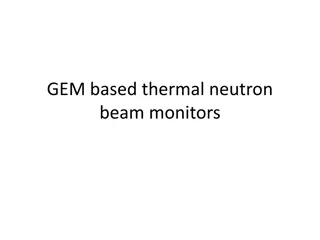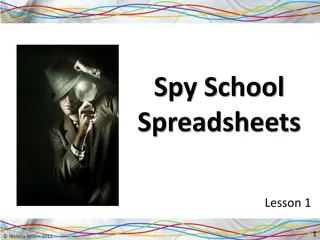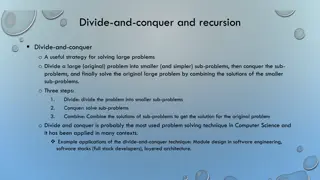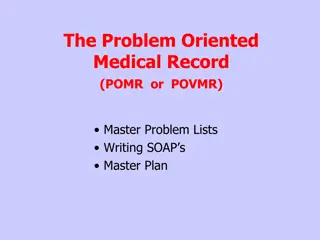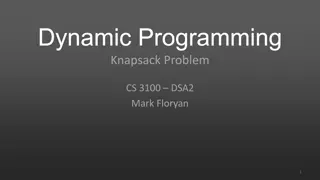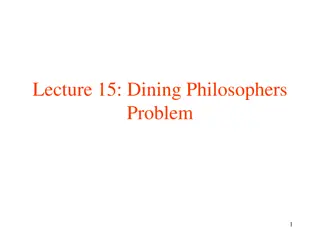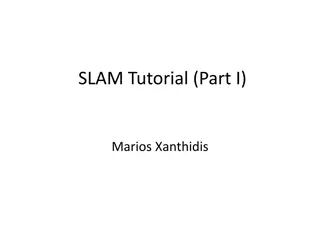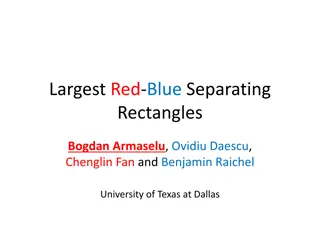Efficient Solutions for Spy Problem: A Detailed Overview
Explore efficient strategies to identify spies among intelligence agents using methods like Single Holdout and Group Elimination. Learn about innovative approaches like CEASER for cache defense against new attacks, such as conflict-based cache attacks. Prior solutions and the CEASER framework are also discussed, highlighting advancements in randomization without tables for enhanced security.
Download Presentation

Please find below an Image/Link to download the presentation.
The content on the website is provided AS IS for your information and personal use only. It may not be sold, licensed, or shared on other websites without obtaining consent from the author.If you encounter any issues during the download, it is possible that the publisher has removed the file from their server.
You are allowed to download the files provided on this website for personal or commercial use, subject to the condition that they are used lawfully. All files are the property of their respective owners.
The content on the website is provided AS IS for your information and personal use only. It may not be sold, licensed, or shared on other websites without obtaining consent from the author.
E N D
Presentation Transcript
New Attacks and Defense for Encrypted-Address Cache ISCA-2019 Moinuddin Qureshi
The Spy Problem There are A agents at intelligence agency and S of them are spies. Find the spies. You can send a given number of agents to a retreat on an island. If all S spies are present at the retreat, they meet to strategize. If even one spy is missing, this spy meeting will not take place. The only information you get is if the spy meeting happened. You can send any number of agents to the retreat. A=1024 and S=17. How many retreats to identify all the spies?
The Spy Problem: Basic Solution Holdout one agent, send rest to retreat. If meeting, holdout not spy, else spy (R=1) (R=2) (R=3) (R=A) Single Holdout Method (SHM) needs ~A retreats, total cost O(Agents^2)
The Spy Problem: Efficient Solution Divide in G groups. Hold out group. If meeting, discard the entire group. (R=1) (R=2) (R=3) Group Elimination Method has cost in the O(A*S) 40x lower than SHM
Outline Spy Problem CEASER New Attacks Defense
Conflict-Based Cache Attacks Co-running spy can infer access pattern of victim by causing cache conflicts B B V A Miss for B Victim Accessed Set LLC CORE (Spy) CORE (Victim) Conflicts leak access pattern, used to infer secret [AES Bernstein 05]
Prior Solutions Table-Based Randomization Way Partitioning NoMo [TACO 12], CATalyst [HPCA 16] RPCache[ISCA 07], NewCache[MICRO 08] Mapping Table (MT) Mapping Table large for LLC (MBs) Inefficient use of cache space OS support needed to protect Table Not scalable to many core
CEASER: Randomization without Tables CEASER uses Encrypted Address + Remapping [MICRO 2018] Robust to attacks (years) Key1 Key2 Negligible slowdown (~ 1%) Encrypt Line Address Negligible storage (24 bytes) Localized change (within cache) Cache No OS support needed Change Key, Periodically Remap Rate of 1% sufficient to provide robustness of years
Anatomy of the Attack Step-1: Trial-and-Error Find L random lines that can cause conflict miss on target set X Step-2: Search Algorithm Use a search algorithm, find W+1 conflicting lines in L LLC Step-3: Launch Attack Launch conflict-based attack until the lines get remapped Attacker needs an efficient search algorithm to form eviction set
State-of-the-Art Search Algorithm (SHM) [Liu et al. S&P, 2015] Form pattern such that cache has a conflict miss D C A X Remove one line from pattern & check conflict B LLC Yes No Conflict Miss? Removed line MAPS to conflicting set Removed line NOT in conflicting set Single Holdout Method (SHM): for L=1200, W=16, need about 1M accesses Can we develop faster attacks than state-of-the-art?
Outline Spy Problem CEASER New Attacks Defense
Attack-1: Fast Search Algorithm (GEM) Divide L in W+1 groups. Hold out group. If conflict, discard the group. (R=1) (R=2) (R=3) Group Elimination Method : L=1200, W=16, accesses reduced from 1M to 40K Remap Rate of CEASER must be increased to >25% to mitigate GEM
Attack-2: Exploit Replacement Policy LRU susceptible to thrashing. Exploit property to avoid search algorithm Access Pattern to Attack LRU D D A B C A B C X X D C A X 3 misses, all to conflicting set No need for search algorithm B LLC D A B C X D X X A B C D A B C Access Pattern to Attack RRIP Attack-2 avoids search algorithm : L=1200, accesses reduced from 1M to ~3K Remap Rate of CEASER must be increased to >100%
Outline Spy Problem CEASER New Attacks Defense Goal: Tolerate Fast Attacks with CEASER while having low Remap-Rate
Skewed-Cache: Diversity of Locations Set-Associative Cache Skewed Cache The Good: Map to different sets B X? A X A/B X? A/B Need (for security): Unpredictable hashes Dynamic changing hashes h2 h1 X Skewed-Cache enables line to map to different sets. Static hash insecure.
Skewed-CEASER Enable CEASER to map lines to different sets via principles of skewing Attacker needs to dislodge target line from multiple possible locations Skewed-CEASER with 2+ partitions possible (stronger security)
Security Analysis Time to get enough number of hard conflict lines (dislodge both locations) Remap-Rate 8MB LLC 1 MB LLC-Bank 1% (default) 0.5% 1 ms per 100+ years 1 ms per 100+ years 1 ms per 18 years 1 ms per day X? A/B X? A/B 0.1% 1 ms per 68 years 1 ms per second Skewed-CEASER can tolerate years of attack (with Remap-Rate of 1%)
Performance and Storage Overheads 8 cores with 8MB LLC 16-way (34 workloads, SPEC + Graph) CEASER Skewed-CEASER Norm Performance (%) 100 Structures CEASER Skewed-CEASER (2) Cost 24 bytes 48 bytes 99 98 97 Skewed-CEASER (4) 96 bytes 96 95 Rate-34 Mix-34 ALL-68 Skewed-CEASER incurs negligible slowdown (~1% ) & overheads (<100 bytes)
Summary Cache randomization makes it harder for the adversary to form eviction sets Concurrent Paper IEEE S&P, May 2019 Attack-1: Fast search algorithm (GEM) Attack-2: Exploit replacement policy, avoid search Skewed Cache (Static) USENIX Security, Aug 2019 Defense: Skewed-CEASER = CEASER + Skewed-Cache Skewed-CEASER has flexibility in placement of line, increased robustness (performance and storage overhead remains negligible)



